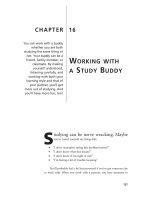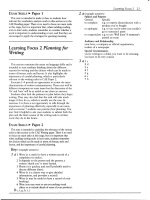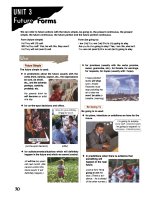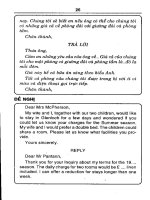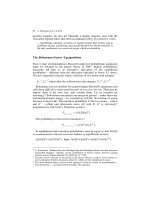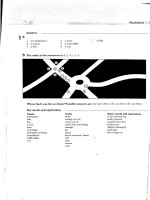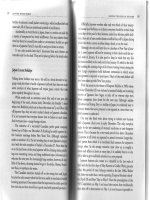Working with a study budy 4 pps
Bạn đang xem bản rút gọn của tài liệu. Xem và tải ngay bản đầy đủ của tài liệu tại đây (70.39 KB, 6 trang )
PREPARING FOR SHORT-ANSWER TESTS
151
M
ATCHING
A matching test is similar to multiple-choice in that the answer is there,
but you have to find it among answers that may be close in definition.
Some matching tests have more choices in one column than in the other.
It’s important you read the directions very carefully so you don’t get
confused by extra choices.
FILL
-IN-THE-BLANK
A fill-in-the-blank test is the opposite of a matching or multiple-choice
test. The answer is not there for you; you have to come up with it yourself.
The best way to prepare for this type of test is to know your vocabulary—
including correct spelling.
READING CLOSELY TO FIND THE CORRECT
ANSWER
Your first clue to a right answer is in reading the question closely. (You
might want to review Chapter 10,“Getting More out of Reading.”) You need
to find out exactly what a question is asking. As you read the test question:
• What questions come to mind?
• What images or words come to mind?
USE YOUR LEARNING STYLE
As always, use the style that suits you best to approach a question. (You
may want to review Chapters 2 through 5 on learning styles.)
• If you learn best by hearing: Read the question out loud (softly, if
others are nearby!).
• If you learn best by seeing: Use scrap paper to write down key
words or draw a picture that comes to mind.
• If you learn best by using images: Turn the question into a picture
or movie in your head. Ask yourself: “What’s needed to complete
the picture?”
HOW TO STUDY
152
• If you learn best by putting things in order: Imagine the question
as a puzzle or comic strip. Ask yourself: “Which of the choices would
make the most sense and complete the puzzle?“
• If you learn best by doing: Imagine yourself acting out the ques-
tion. Hold on to the picture of you in your head. Ask yourself:
“Which of the two choices would you pick in that situation?”
HOW TO
APPROACH THE QUESTIONS
Start by quickly skimming through the test to find the questions that are
easiest for you. You’ll save time if you do challenging questions later.
Remember, only correct answers count! If your test is timed, you’ll get
more correct answers down on paper by doing the ones you know for
sure first.
Tackle each question, one at a time.
1. When you read the question, cover up your choice of answers.
Think only of the question. What answer comes to mind? Hold
on to the answer in your head, or write it down if you’re
permitted to use scrap paper.
2. Now look for the answer among the choices given that comes
closest to your answer. When you know the answer, not looking at
the choices first can save you time. Answer all the easy questions
this way.
After you’ve answered all the questions you know for sure, go back
to the challenging ones. Begin by picking a question you feel more com-
fortable with and read it again. Sometimes a bell will go off in your head
the second time around. If you’re working with a matching section,
you’ve probably already eliminated some possible choices by answering
the easy questions. On a multiple-choice test, if you’re still not sure of the
answer:
1. Rule out the answer that’s not close at all.
2. Rule out the answer that’s loosely associated, but not close.
1.
2.
3.
PREPARING FOR SHORT-ANSWER TESTS
153
3. Now you have to choose between one answer that’s correct and
one answer that’s very close. You’re making an educated guess
here. Use your learning style! (See the suggestions above.)
Choose one answer to the practice question below:
A worker who is cognizant of her learning strengths, no
matter what job she is doing, is more apt to do well.
In the sentence above, cognizant most nearly means
a. proud
b. aware
c. highly knowledgeable
d. automated
Making an Educated Guess
Use your learning style to make sense of the question.
• If you learn best by using images: See a picture of a worker doing
her job well.
• If you learn best by putting things in order: Imagine the different
steps involved in getting a job done well.
• If you learn best by doing: Imagine yourself doing very competent
work.
In the question above, maybe you ruled out the “way out” answer, d,
right away. Answer a might be a result of doing good work, but it doesn’t
define cognizant. Looking quickly, you might have thought, “Cognizant—
well, it has something to do with knowing, so the answer is c.”But c is the
trick answer—the answer that is almost correct. A trick answer can confuse
you if you don’t read carefully. The word cognizant is connected with
knowledge, but it simply means being aware, not highly knowledgeable. To
do a job well, you have to be aware of how you work best. The correct
answer then, is b.
Try It!
1.
2.
3.
Practice Tip
As you read—a magazine in the barber shop, a newspaper on your way
to work, a message on the TV screen—choose a word that seems
important in a particular sentence. Create an association with that
word, something that will help the word stick with you. Practicing in
everyday situations will make coming up with associations easier; then
you’ll be able to study more efficiently.
HOW TO STUDY
154
IN SHORT
To do the best you can on an test, keep calm, read carefully, and answer
shrewdly. Begin by answering questions you know for sure. Then go back
to the tougher ones, starting with those that are the least difficult. When
you know fill-in-the-blanks will be included, practice beforehand by
making your own associations with the words and terms you might be
tested on. Carry the cards with you and tape them up where you’ll see
them. Explore the techniques that work best with your learning style.
155
CHAPTER
19
PREPARING FOR
ESSAY TESTS
Taking an essay test
involves several steps:
reviewing the whole
test first, deciding how
much time to spend
on each question,
carefully reading
each question and
answering it fully,
and finally, checking
each answer.
A
n essay test asks questions that can’t be
answered in short, simple facts. Each question requires that
you think about the answer and spend time answering it in
writing, but there is a lot you can do in advance. The Boy Scouts have a
motto: Be prepared! Before the test, you can prepare for both direct and
indirect questions by asking yourself (or, if you have a study buddy,
asking each other) questions directly from the text and questions based
on the text and writing down your answers. Begin by reviewing Chap-
ter 15, “Making Yourself Understood.”
Use Your Study Styles
Mathilda is studying to be an accountant and she just learned
she’ll have to take an essay test to complete the class. Her math
teacher wants to see how she thinks and solves problems. “But
I just work with numbers!” she says. “I don’t need to write in
this job!” What Mathilda will see is that she can use her
strength as someone who works best with order as a sequential
learner to become a sequential writer.
HOW TO STUDY
156
GETTING READY
A good way to prepare yourself for an essay question is to write a mock
test ahead of time. By acting (creating questions) and not just reacting
(answering questions), you become involved in the test preparation
process. To begin, pretend you’re the instructor:
• Make a list of what you want your students to get out of the
course and the class materials, such as hand-outs, pamphlets, and
books.
• Circle the three items you feel are most important to the course.
• Make up a question for each of these items. If you’re working
with a study buddy, each make up your own list and separate
questions. Include both direct questions, which are answered by
facts from your notes or text, and at least one indirect question,
which is based on how you put facts together to come up with
a conclusion.
• Write an answer to each question. If you’re working with a study
buddy, swap the tests you made and take each other’s test. Make
sure you each have an answer sheet that includes page numbers
that indicate where the answers can be found in your class material.
TIME MANAGEMENT
You want to make the most of the time allotted for taking the test so that
you have sufficient time for answering and checking each question before
the time is up.
